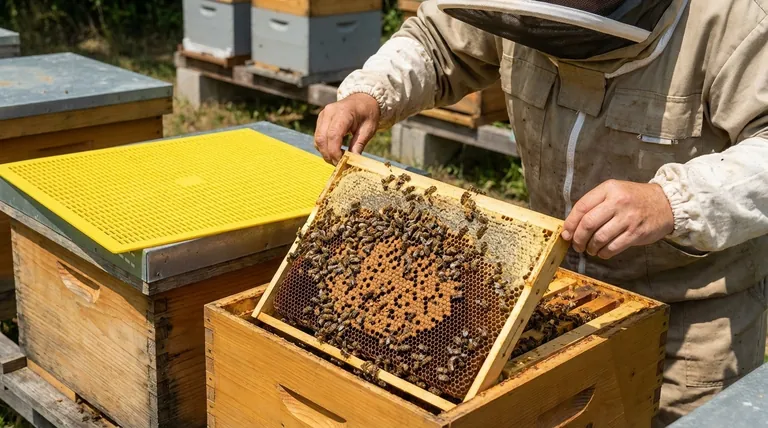In short, removing a queen excluder directly boosts the queen's productivity. By giving her unrestricted access to the entire hive, she is free to lay eggs in any suitable cell, which can significantly increase the total number of frames dedicated to brood and lead to a much larger hive population.
The decision to use an excluder is a strategic choice between maximizing the hive's population for a major nectar flow and ensuring a simplified, clean honey harvest. Understanding this core trade-off is fundamental to effective hive management.

The Principle: More Space Equals More Brood
To understand the effect of removing an excluder, we first must understand its function. It is a simple physical barrier designed to control the queen's movement.
How an Excluder Works
A queen excluder is a grid with gaps large enough for worker bees to pass through but too small for the queen's larger thorax. The gaps are typically between 4.1 and 4.4 millimeters.
Its sole purpose is to confine the queen to the lower brood boxes, preventing her from laying eggs in the upper boxes, known as honey supers.
The Impact of Removal
Without this barrier, the queen's domain expands from the brood chamber to the entire hive. She is free to move upwards and lay eggs in any cell the workers have prepared.
This means she is no longer limited by the space available in the designated brood boxes. As the colony expands, she can continue laying in an unbroken pattern into the upper supers.
The Resulting Population Boom
This unrestricted access to space allows the queen to reach her maximum laying potential. The direct result is a significant increase in the amount of brood in the hive.
A larger brood nest produces a larger population of bees. A larger workforce of foragers can, in turn, collect more nectar during a flow, potentially leading to greater honey production.
Understanding the Trade-offs
While boosting the queen's productivity sounds like a clear benefit, it introduces significant management complexities. The choice to go "excluder-less" is not without its costs.
The Benefit: A Larger Workforce
The primary advantage is a massive population. For beekeepers looking to build up a colony's strength before a major nectar flow, removing the excluder is a powerful strategy to create a formidable foraging army.
The Drawback: A Mixed-Use Hive
When the queen moves into the supers, she lays eggs among the cells being used for honey storage. This creates a "chimney" effect, where frames contain a mix of brood, pollen, and nectar.
The clean separation between the "nursery" (brood box) and the "pantry" (honey supers) is lost.
The Consequence: Complicated Honey Harvest
This mixing of brood and honey makes harvesting extremely difficult. Every frame in the supers must be carefully inspected for eggs and larvae before it can be extracted.
Extracting honey from a frame containing brood is not feasible, as it destroys the developing bees and contaminates the honey. This adds considerable time and labor to the harvesting process.
Making the Right Choice for Your Goal
Your decision to use an excluder should be based on your specific objective for the hive at that moment.
- If your primary focus is maximizing hive population for a major nectar flow: Removing the excluder allows the queen to build a massive workforce that can capitalize on the available resources.
- If your primary focus is simplified management and a clean honey harvest: Using an excluder is the standard approach, as it cleanly separates the brood nest from the honey supers.
Ultimately, understanding this relationship between space, productivity, and management allows you to guide your colony with clear intention.
Summary Table:
| Scenario | Queen's Productivity | Hive Population | Honey Harvest Complexity |
|---|---|---|---|
| With Excluder | Confined to brood boxes | Controlled | Simple & Clean (Brood and honey separated) |
| Without Excluder | Maximized (Unrestricted access) | Massive Boom | Complex & Laborious (Brood mixed with honey) |
Ready to build a stronger, more productive apiary?
At HONESTBEE, we supply commercial apiaries and beekeeping equipment distributors with the durable, high-quality tools needed to implement advanced hive management strategies—whether you manage with or without an excluder.
Let us help you maximize your operation's potential. Contact our wholesale experts today to discuss your specific needs and volume pricing on essential beekeeping supplies and equipment.
Visual Guide

Related Products
- Professional Plastic Queen Excluder for Modern Beekeeping
- Wooden Queen Bee Excluder for Beekeeping
- Premium Wood Framed Metal Wire Queen Bee Excluder
- Metal Queen Bee Excluder for Beekeeping
- High Performance Plastic Queen Excluder for Beekeeping and Apiary Management
People Also Ask
- What is the purpose of a queen excluder when adding a super? Streamline Your Honey Harvest
- What are the pros of using a queen excluder? Boost Hive Control & Honey Quality
- What is the primary function of a queen excluder in beekeeping? Control Hive Layout for Efficient Honey Harvesting
- What are the main advantages of using a queen excluder in beekeeping? Simplify Hive Management & Harvest
- How does a queen excluder work? Master Hive Management for Pure Honey Harvests



















